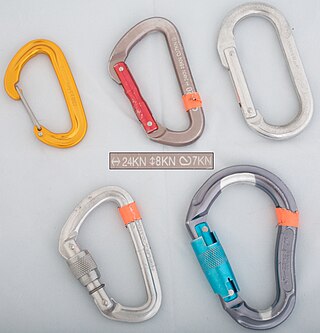
A carabiner or karabiner, often shortened to biner or to crab, colloquially known as a (climbing) clip, is a specialized type of shackle, a metal loop with a spring-loaded gate used to quickly and reversibly connect components, most notably in safety-critical systems. The word comes from the German Karabiner, short for Karabinerhaken, meaning "carbine rifle hook" used by a carbine rifleman, or carabinier, to attach his carbine to a belt or bandolier.

A fence is a structure that encloses an area, typically outdoors, and is usually constructed from posts that are connected by boards, wire, rails or netting. A fence differs from a wall in not having a solid foundation along its whole length.
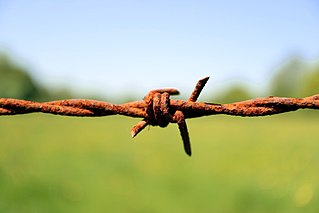
Barbed wire, also known as barb wire, is a type of steel fencing wire constructed with sharp edges or points arranged at intervals along the strands. Its primary use is the construction of inexpensive fences, and it is also used as a security measure atop walls surrounding property. As a wire obstacle, it is a major feature of the fortifications in trench warfare.
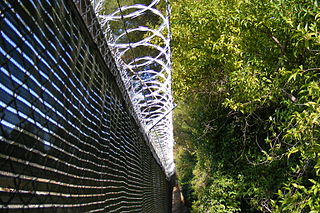
Barbed tape or razor wire is a mesh of metal strips with sharp edges whose purpose is to prevent trespassing by humans. The term "razor wire", through long usage, has generally been used to describe barbed tape products. Razor wire is much sharper than the standard barbed wire; it is named after its appearance but is not razor sharp. The points are very sharp and made to rip and snag clothing and flesh.

In agriculture, fences are used to keep animals in or out of an area. They can be made from a wide variety of materials, depending on terrain, location and animals to be confined. Most agricultural fencing averages about 4 feet (1.2 m) high, and in some places, the height and construction of fences designed to hold livestock is mandated by law.

A lock is a mechanical or electronic fastening device that is released by a physical object, by supplying secret information, by a combination thereof, or it may only be able to be opened from one side, such as a door chain.
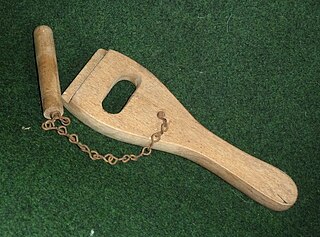
A webbing stretcher is an upholstery tool used to stretch webbing.
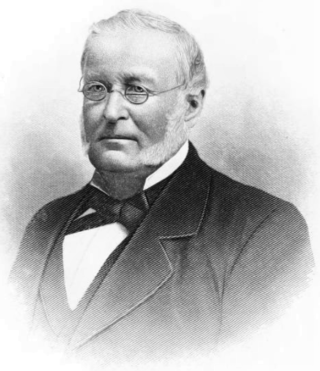
Joseph Farwell Glidden was an American businessman and farmer. He was the inventor of the modern barbed wire. In 1898, he donated land for the Northern Illinois State Normal School in DeKalb, Illinois, which was renamed as Northern Illinois University in 1957.

A buckle or clasp is a device used for fastening two loose ends, with one end attached to it and the other held by a catch in a secure but adjustable manner. Often taken for granted, the invention of the buckle was indispensable in securing two ends before the invention of the zipper. The basic buckle frame comes in a variety of shapes and sizes depending on the intended use and fashion of the era. Buckles are as much in use today as they have been in the past: used for much more than just securing ones belt, instead they are one of the most dependable devices in securing a range of items.

A lever tumbler lock is a type of lock that uses a set of levers to prevent the bolt from moving in the lock. In the simplest form of these, lifting the tumbler above a certain height will allow the bolt to slide past.
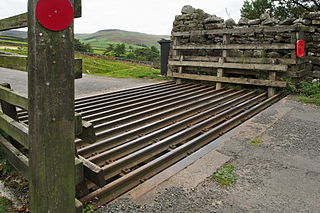
A cattle grid – also known as a stock grid in Australia; cattle guard, or cattle grate in American English; vehicle pass, or stock gap in the Southeastern United States; Texas gate in western Canada and the northwestern United States; and a cattle stop in New Zealand English – is a type of obstacle used to prevent livestock, such as sheep, cattle, pigs, horses, or mules from passing along a road or railway which penetrates the fencing surrounding an enclosed piece of land or border. It consists of a depression in the road covered by a transverse grid of bars or tubes, normally made of metal and firmly fixed to the ground on either side of the depression, so that the gaps between them are wide enough for an animal's feet to enter, but sufficiently narrow not to impede a wheeled vehicle or human foot. This provides an effective barrier to animals without impeding wheeled vehicles, as the animals are reluctant to walk on the grates.

A rotary combination lock is a lock commonly used to secure safes and as an unkeyed padlock mechanism. This type of locking mechanism consists of a single dial which must be rotated left and right in a certain combination in order to open the lock.

An electric fence is a barrier that uses electric shocks to deter people and/or other animals from crossing a boundary. The voltage of the shock may have effects ranging from discomfort to death. Most electric fences are used for agricultural fencing and other forms of non-human animal control, although they are also used to protect high-security areas such as military installations or prisons, where potentially-lethal voltages may be used. Virtual electric fences for livestock using GPS technology have also been developed.
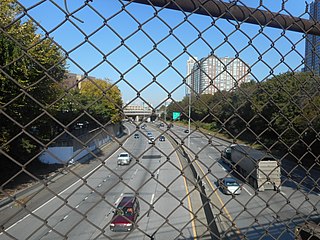
A chain-link fence is a type of woven fence usually made from galvanized or linear low-density polyethylene-coated steel wire. The wires run vertically and are bent into a zigzag pattern so that each "zig" hooks with the wire immediately on one side and each "zag" with the wire immediately on the other. This forms the characteristic diamond pattern seen in this type of fence.

Mechanical railway signalling installations rely on lever frames for their operation to interlock the signals, track locks and points to allow the safe operation of trains in the area the signals control. Usually located in the signal box, the levers are operated either by the signalman or the pointsman.

Number 8 wire is a 0.16-inch-diameter (4.064 mm) gauge of wire on the British Standard Wire Gauge that has entered into the cultural lexicon of New Zealand.

California Valley Airport was a privately owned restricted-use airport located adjacent to the community center of California Valley, in the sparsely populated Carrizo Plain of San Luis Obispo County, California, United States.
Eben Ernest Hayes was a New Zealand engineer and inventor who founded the Hayes Engineering works in Oturehua, Central Otago. He developed a wind turbine and manufactured wind pumps and agricultural tools for farms.

In the Western United States and Canada, open range is rangeland where cattle roam freely regardless of land ownership. Where there are "open range" laws, those wanting to keep animals off their property must erect a fence to keep animals out; this applies to public roads as well. Land in open range that is designated as part of a "herd district" reverses liabilities, requiring an animal's owner to fence it in or otherwise keep it on the person's own property. Most eastern states and jurisdictions in Canada require owners to fence in or herd their livestock.
The Fence Cutting Wars occurred near the end of the 19th century in the American Old West, and were a series of disputes between farmers and cattlemen with larger land holdings. As newcomers came to the American West to farm, established cattlemen began to fence off their larger tracts of land with barbed wire in order to protect them from the farmers' claims. The settlers viewed this as a closing of the open range, and began to cut fences to attempt to reclaim lands in the public domain. The ensuing, widespread series of conflicts was known as the Fence Cutting Wars.



















